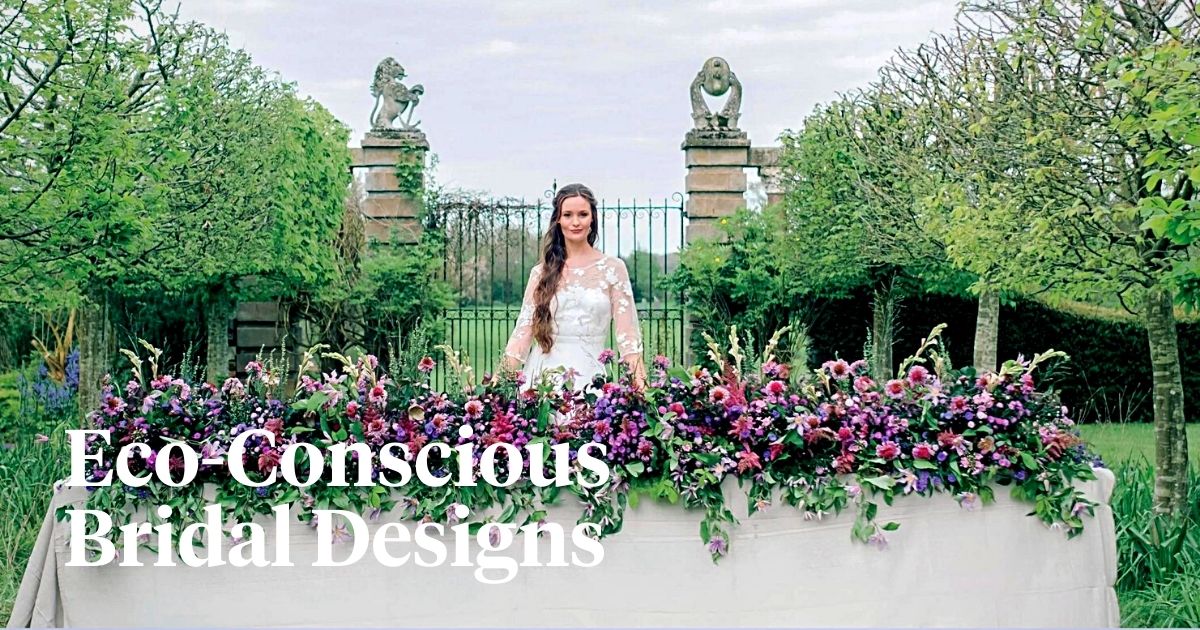With a remarkable career spanning over four decades, Sabine Darrall is, without a doubt, quite an illustrious figure in the English wedding and event floral design scene. The English florist is known for her specialty in these fields, with a particular incorporation of sustainability and eco-awareness.
With a kind of sophistication unique to her creations, and a constant desire, innovative approach, and matter-of-fact demeanor, she has kept on enthralling audiences and enlightening other emerging florists to blend their floral design artistic ideas with sustainable environmentally friendly practices.
Sabine’s Eco-Friendly Bridal Workshop
Did you know that floral arrangements are at the heart of wedding decorations? Flowers symbolize love and passion. Whether it is in a classic, bohemian, or extravagant wedding theme; using flowers emphasizes the love of the couple.

Photo by @sabinefloral
For Sabine, this provided sufficient inspiration to organize a three-day bridal workshop centered around environmentally friendly practices in wedding décor. Her expertise, which lies in creative installations and event designs, was imparted with a thoughtful commitment to sustainable practices. For her, this three-day bridal workshop was a celebration of sustainable elegance in the art of wedding floristry.
When it comes to wedding decorations, floral arrangements reign supreme. These appealing creations not only embellish the venue but also symbolize the very essence of love. Regardless of whether one is arranging a classic, bohemian, or extravagant theme, the use of flowers accentuates the deep connection between the couple.

In her context, this realization served as a source of inspiration for Sabine, guiding her — and her team of talented florists — to organize a remarkable three-day bridal workshop centered around environmentally friendly practices.
The florist who divides her time between managing a successful floral design business and coaching others with her extensive knowledge, through workshops, held this workshop at her organic farm nestled in the picturesque countryside of Herefordshire.
Wedding Floral Designs Showcasing Marginpar's Exquisite Blooms
Sabine’s attraction to Marginpar’s flowers came when she first set her eyes upon the Clematis Amazing® Sevilla. This exquisite flower perfectly captured the essence of her bridal bouquets, kindling a love affair that has persisted.

Photo by @sabinefloral
With her continued interaction with Marginpar, she discovered other stunning blooms, each with its own unique story, quality, and variety.
Sabine Darrall:
“I fell in love with Marginpar when I first saw the Clematis Amazing® Sevilla, just the perfect flower for my style of bridal bouquet. Then I discovered all the other beautiful flowers that Marginpar grows. I love the varieties, the quality, and the story behind the blooms...”
Thenceforth, in her eco-friendly bridal workshop, Sabine skillfully incorporated these outstanding flowers into her designs.

From breathtaking bridal bouquets adorned exclusively with the Clematis Amazing® series to fascinating creations showcasing Aster, Scabiosa, Astilbe, and Delphinium, every arrangement was not only visually appealing but also a demonstration of ecological responsibility.
So, together with an ensemble of talented participants, she created a series of remarkable floral designs. Each day of the three-day workshop was dedicated to a distinct wedding theme, allowing the participants to engross themselves in the art of crafting an ambiance that radiated the essence of an actual wedding celebration.

Step-by-Step Guide to Making a Sustainable Floral Table Runner
What you need:
- Lightweight wood plank
- +/- 1.80 meters wire netting
- Oasis FibreFloral™ Design Media (plastic-free)
- Compostable bags
- Staple gun
- Osmanthus foliage
- +/- 80 stems of the Clematis Amazing® series
- +/- 60 x Scabiosa Focal Scoop™ Bicolor Pink
- +/- 60 x Panicum Heavy Metal
- +/- 80 x Scutellaria Tinkerbell
- +/- 80 x Helleborus Moondance
- +/- 20 x Polianthes Epic Elsa
- +/- 40 x Phlox Pink Eyes

Step 1: Take seven blocks of Oasis FibreFloral™ and place each one within a compostable bag. This prevents water drips and makes it easier to insert the flower stems later.
Step 2: Position the foam blocks on the wood plank. Lay the plank on a flat surface and arrange the compostable bags with the foam blocks evenly spaced along the length of the wood plank.
Step 3: Cover the entire arrangement, including the compostable bags and foam blocks, with a layer of wire netting. Use a staple gun to firmly secure the wire netting to the wood plank, ensuring the foam blocks are held in place.

Step 4: Start by inserting a layer of Osmanthus foliage into the wire netting. This covers the mechanics and serves as the base for the design. Add a layer of Aster, then layers of Astilbe, Polianthes, Scabiosa, Helleborus, Panicum grass, Phlox, Scutellaria, and Clematis. The design can then be lifted in one piece and placed in the right place. Finish by adding more Clematis stems to trail down the front of the table.
Steadfast Commitment to Sustainable Practices
For the designs, the procedures employed in constructing the floral table runner, including the reusable wood plank, wire netting, and compostable bags, epitomized Sabine's firm dedication to sustainability.

Compostable bags and any plant-based materials from the designs were destined for the compost, while other recyclable components were carefully sorted and recycled. This holistic and eco-friendly approach to floral design not only reduces waste but also promotes a pleasant connection with nature and the planet.
Furthermore, the versatility of Sabine's designs allows for easy adaptation and repurposing, transforming them into other elements like floor meadows that can grace various occasions.

This flexibility showcases the true essence of sustainable floral design and its ability to bring beauty to any setting.
Photos courtesy of Marginpar (@marginpar).











